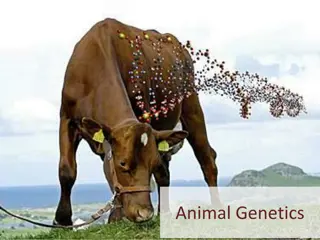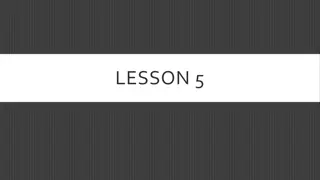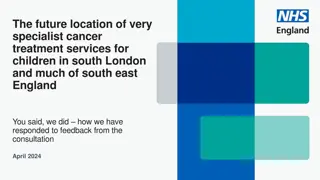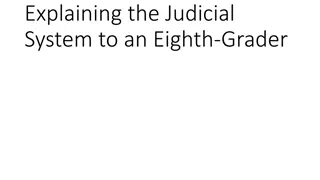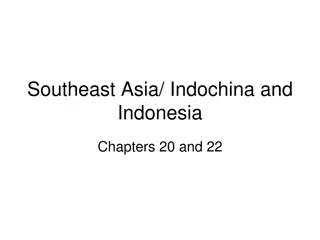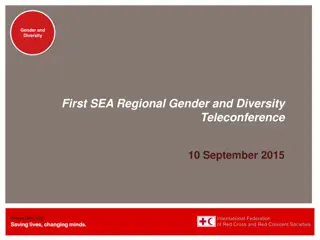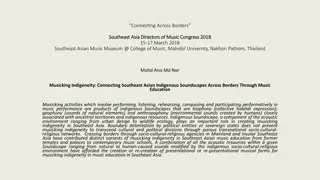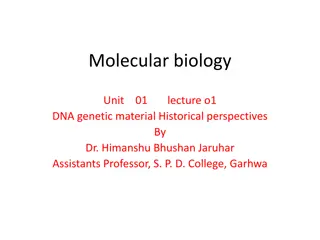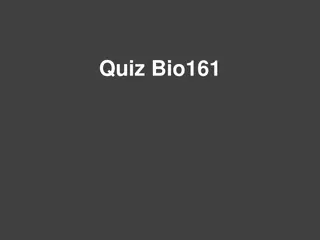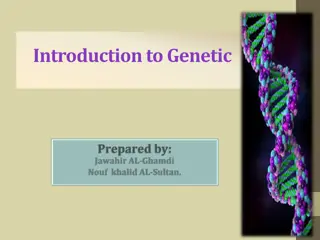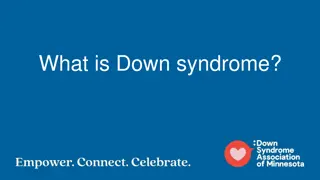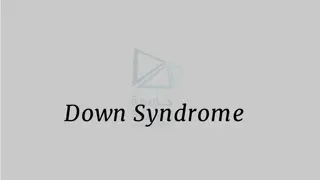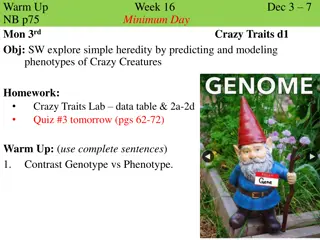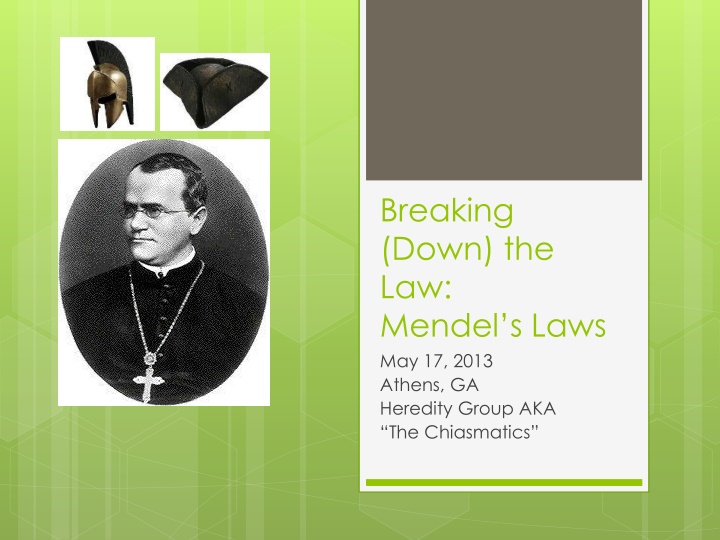
Understanding Mendel's Laws and Genetic Inheritance
Explore Mendel's laws of inheritance, allelic segregation, and independent assortment through the process of meiosis and sexual reproduction in this comprehensive biology unit. Gain insights into key concepts like genotypes, phenotypes, Punnett squares, and more.
Download Presentation

Please find below an Image/Link to download the presentation.
The content on the website is provided AS IS for your information and personal use only. It may not be sold, licensed, or shared on other websites without obtaining consent from the author. If you encounter any issues during the download, it is possible that the publisher has removed the file from their server.
You are allowed to download the files provided on this website for personal or commercial use, subject to the condition that they are used lawfully. All files are the property of their respective owners.
The content on the website is provided AS IS for your information and personal use only. It may not be sold, licensed, or shared on other websites without obtaining consent from the author.
E N D
Presentation Transcript
Breaking (Down) the Law: Mendel s Laws May 17, 2013 Athens, GA Heredity Group AKA The Chiasmatics
Unit Context Introductory level majors biology 2-3 Weeks, OR As long as it takes to achieve the learning objectives
Unit Learning Goal Students will understand how allelic segregation and independent assortment result in inheritance of characteristics through the process of meiosis and sexual reproduction.
Unit Outcomes Define terms(Knowledge) and describe their hierarchical relationships (Comprehension): locus, gene, alleles, DNA, chromosomes, gametes, segregation, independent assortment Explain the process of segregation and independent assortment and how it relates to crosses. (Comprehension) Given parental genotype of a cross, predict phenotypic and genotypic frequency for two traits using Punnett square. (Application)
Unit Outcomes Given a phenotypic ratio, infer parental genotypes (Analysis) Create a diagram that demonstrates the segregation of alleles at two independently- assorting genes during gamete formation. (Synthesis) Diagram how the process of meiosis gives rise to gametes for two independently-assorting traits. (Synthesis) Given a set of data, determine if the data provided fit a particular type of inheritance. Provide a possible explanation to support your inference (Evaluation).
Tidbit Rationale: Why did we choose this particular learning objective? Relative importance of this topic as a foundation for future concepts (scaffolding) Difficult concept for students to learn (high abstraction and cognitive load) Many misconceptions about this topic and its connection to meiosis
Prior Knowledge: Students will Understand DNA as genetic material (allele, chromosome) Understand meiosis and sexual reproduction Understand and complete monohybrid crosses.
X AA aa ? What is the genotype of the offspring? A) B) C) D) Aa aa AA BB
Tidbit Step 1 Open envelope #1, which contains 8 pieces of paper each of which represents an allele (A, a, B, b). Use these pieces of paper to create all the possible gametes produced by a heterozygous parent through independent assortment.
Review Question Looking at your cards, what does each letter represent? A. Chromosome B. Allele C. Gene D. Gamete
Review Question Looking at your cards, what do the upper versus lower case letters represent? A. Dominant vs. Recessive Alleles B. Dominant vs. Recessive Genes C. Genotype vs. Phenotype D. Homozygous vs. Heterozygous E. Male vs. Female Gamete
Review Question What cell division process creates the haploid cells that become or produce gametes? A) Mitosis B) Meiosis C) Fission D) Budding
Clicker Question Which of the following is the correct set of possible gametes for your cards? A. AA, Aa, BB, Bb B. A, B, a, b C. AB, ab, AB, ab D. aa, bb, BB, AA E. AB, Ab, aB, ab
Tidbit Step 2 We need 8 student volunteers. Please grab one sign from the table. You are a chromosome from a diploid organism with two chromosome pairs (see diagram above).
Tidbit Step 3 Organize yourselves into gametes. Prompt questions Are gametes haploid or diploid? Do gametes have two copies of the same gene? Is this all the possible combinations?
Tidbit Step 4 Line up students horizontally at front of class
Tidbit Step 5 Now open the second envelope , which contains 8 more pieces of paper each of which represents an allele (A, a, B, b). Use these pieces of paper to create all the possible gametes from the heterozygous male parent.
Tidbit Step 6 We now need 8 more volunteers. Please grab a card and organize yourselves into gametes. Line up at a right angle to original group (e.g. on left aisle of the classroom).
Clicker Question Notice that each of the two groups have slightly different color shades (bright and pale). What do the two shades represent? A) Different alleles B) Different genes C) Different chromosomes D) Different sexes
Tidbit Step 7 What have we just created? Now sit down and check your cards and rearrange them so that they match what we have created.
A B Aa aA aa AB Ab aB ab AA BB AB Bb Ab bB aB bb ab Which Punnett square represents a cross between two heterozygous parents? C D AA AA BB BB AA AA aa aa aa BB aa BB bb bb bb bb
Clicker Question What does each two-letter combination (e.g., AB) represent, assuming independent assortment? A) Alleles from 2 genes on 1 chromosome B) Alleles from 2 genes on 2 different chromosomes C) 2 alleles from 1 gene D) The same allele from different sexes
On paper, identify the different parts of the Punnett square numbered below. 1 3 AB Ab aB Ab AB 2 Ab aB Ab
Summative Assessment Questions: Reflection: Summarize the activity that we completed in class today using the following terms: alleles, independent assortment, meiosis, gamete, and random segregation. 1. Assume a simple dominant inheritance pattern in peas with Y = green, y = yellow, R = round, and r = wrinkled. Find the genotypic and phenotypic ratio from the following two crosses RrYy x RrYy RrYy x rryy 2. a. b.
Possible Extensions Use this human demonstration technique to model meiosis and gamete formation. 1. Extend the human Punnett square here to show a male and female gamete joining to produce an offspring. (Or even using lots of volunteers to show all possible offspring combinations in the Punnett square this would require 64 additional volunteers and appropriate space to create the entire Punnett square.) 2. Let the letters represent alleles for real world traits to make the process more tangible. 3.
References I Mbajiorgu. (2007). Science Education, 91(3), 419-438. Kibuka-Sebitosi. (2007). J. o. Biological Education, 41(2), 56-61. Brown. (1990). J. o. Biological Education, 24(3), 182-186. Smith. (1991). J. o. College Science Teaching, 21(1), 28-33. Oztap, Ozay, & Oztap (2003). J. o. Biological Education, 38(1), 13-15.
References II Dikmenli. (2011). Scientific Research & Essay, 5(2), 235-247. Ozcan, Yildirim, & Ozgur. (2012). Procedia Social & Behavioral Research, 46, 3677-3680 Karagoz & Cakir. (2011). Educational Sciences: Theory & Practice, 11(3), 1668- 1674. Sesli & Kara. (2012). J. o. Biological Education, 46(4), 214-225.


